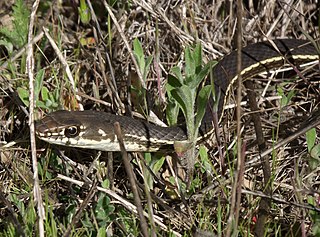
Cryptoblepharus is a genus of skinks, lizards in the family Scincidae. The genus contains at least 53 species.

Gerrhosaurus is a genus of lizards native to southern and eastern Africa.
Edward Hallowell was an American herpetologist and physician.

Atheris squamigera is a venomous viper species endemic to west and central Africa. No subspecies are currently recognized.

Tropidoclonion is a genus of snake in the subfamily Natricinae of the family Colubridae. The genus is monotypic, containing the sole species Tropidoclonion lineatum, commonly known as the lined snake. The species is endemic to North America.

Nerodia is a genus of nonvenomous colubrid snakes commonly referred to as water snakes due to their aquatic behavior. The genus includes nine species, all native to North America. Five of the species have recognized subspecies.

The western green mamba is a long, thin, and highly venomous snake species of the mamba genus, Dendroaspis. This species was first described in 1844 by American herpetologist Edward Hallowell. The western green mamba is a fairly large and predominantly arboreal species, capable of navigating through trees swiftly and gracefully. It will also descend to ground level to pursue prey such as rodents and other small mammals.

Rhamnophis is a genus of arboreal venomous snakes, commonly known as dagger-tooth tree snakes or large-eyed tree snakes, in the family Colubridae. The genus is endemic to equatorial sub-Saharan Africa. There are two recognized species.

The twig snakes, also commonly known as bird snakes or vine snakes, are a genus of rear-fanged venomous snakes in the family Colubridae. The genus is native to Africa. All species in the genus have a slender and elongated profile, a long tail, a narrow head and a pointed snout. The eye of all species has a horizontal pupil, shaped like a keyhole, which gives twig snakes binocular vision. Twig snakes are greyish-brown with faint light and dark markings. When threatened, they inflate the throat to display bold black markings between the scales. Twig snake bites are potentially deadly: the venom is hemotoxic, affecting the blood clotting mechanism and causing uncontrolled bleeding and internal hemorrhaging. Bites by twig snakes have caused death in humans; famous herpetologist Robert Mertens died after being bitten by his pet savanna vine snake. However, envenomed bites are extremely rare when not handling the snake, as the fangs can't breach the skin except in a few places like the web between the thumb and fingers.

The California whipsnake, also known as the striped racer, is a colubrid snake found in habitats of the coast, desert, and foothills of California.

The striped whipsnake is a species of nonvenomous snake in the family Colubridae. It is closely related to the California whipsnake. The striped whipsnake is native to the western United States and adjacent northern Mexico.

Lycophidion is a genus of nonvenomous lamprophiid snakes commonly referred to as the wolf snakes.

The forest cobra, also commonly called the black cobra and the black and white-lipped cobra, is a species of highly venomous snake in the family Elapidae. The species is native to Africa, mostly the central and western parts of the continent. It is the largest true cobra species with a record length of 3.2 metres.

The large-eyed green tree snake, also known commonly as the splendid dagger-tooth tree snake, is a species of venomous snake in the family Colubridae. The species is endemic to Africa. There are three recognized subspecies.
The spotted dagger-tooth tree snake is a species of venomous snake in the family Colubridae. The species is indigenous to Middle Africa.

Toxicodryas blandingii, commonly known as Blanding's cat snake and Blanding's tree snake, is a species of rear-fanged venomous snake of the family Colubridae. The species is endemic to Sub-Saharan Africa.

Toxicodryas is a genus of rear-fanged venomous snakes in the family Colubridae.
Thrasops flavigularis, the yellow-throated bold-eyed tree snake , is a species of snake of the family Colubridae.
Thrasops jacksonii, also known commonly as the black tree snake and Jackson's black tree snake, is a species of snake in the subfamily Colubrinae of the family Colubridae. The species is native to Central Africa.















